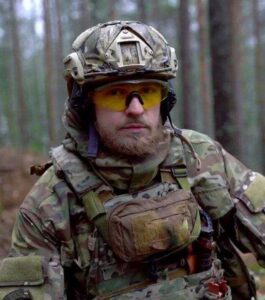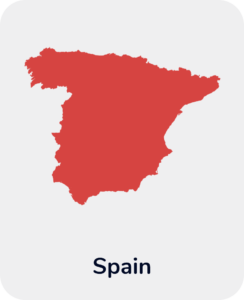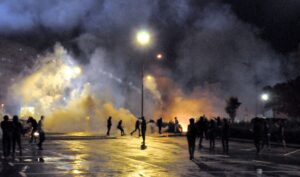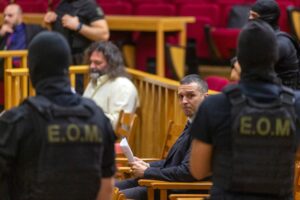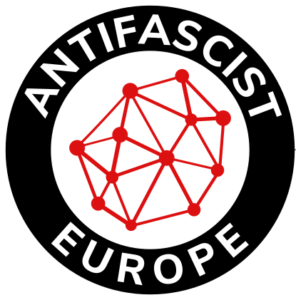This article is part 4 of 7 in the Hammerskins Series. This series was originally published in German via Exif – Recherche & Analyse, and gives us an in-depth look into one of the oldest and most stable neo-Nazi organisations worldwide. This fourth part of the series analyses how all of their activities are funded via multiple streams of revenue.
Part 1 of this series draws a larger picture of the network, its history, and its organisational infrastructure. Part 2 explains the identity of Hammerskins and its members, their rules and codes, as well as symbols and visuals they deploy. Part 3 gives a detailed account and explanation of their engagement in criminal activities, such as murder and terror attacks. Part 5 sheds light on the role of Hammerskins in the ‘NSU Complex’. Part 6 delves into the transnational aspect of the organisation and associated problems they face because of it. The final part of the series, Part 7, focuses on the failure of German intelligence services to identify Hammerskins as an influential actor within right-wing extremism in Germany and worldwide. One central goal of this series is to drag Hammerskins workings out of the shadows and give possibility to the developing of counter-strategies, which so far seemingly has not happened.
Membership fees, merchandise and group funds
Around the turn of the millennium, each member of “Hammerskins Sachsen” was expected to pay 50 Deutschmarks (unemployed members half the amount) into its chapter fund. Beyond this, every chapter is to collect ten euros per month—per “full member” and per “prospective member” – for the “Germany fund” of the “Hammerskin Nation” (HSN), as demanded by the treasurer of “Hammerskins Bayern” in 2011. There are also funds from the brotherhood’s own exclusive merchandise.
In the 1990s, members of the Saxony chapter are said to have kept a car and financed concert tickets from their group fund. Today, the finances are used to sponsor, say, international visits between branches. For example, in 2011, a leading Hungarian Hammerskin thanked all the European chapters for flight tickets to the USA. Jason Brown, the American Hammerskin and singer with the band “Code of Violence” also had half of his flight ticket paid for by the European Hammerskin fund when he attended the Saxony and Berlin chapters in 1999.
In Germany, more than 30,000 euros were generated each year from membership dues alone—assuming 120 to 150 paying members and “prospects”. In addition to the “Germany fund” and the chapter funds, there are other, in part temporary, pots of money. For example, there was a “football fund”, managed by the Mecklenburg chapter, and a “summer camp” fund in order to pre-finance the annual HSN camp.
HSN funds can also be understood as a source for financing CD productions. At the chapter level, “Hammerskins Berlin” contributed 10,000 Deutschmarks to the production of a CD by the band “D.S.T.”. The HSN generates revenues through its own music productions and its services in the organisation of right-wing rock concerts.
“Hammerskins Sachsen” received 5,000 Deutschmarks from the Swiss concert organiser Olivier Kunz for assisting in the organisation of a concert in the late 1990s. In 2000, the HSN received 3,000 Deutschmarks in transfer fees from Jan Werner from Chemnitz. He had organised a concert with “The Bully Boys” in France and was a member of “Blood & Honour Deutschland”. The band was widely considered to be a Hammerskin band. Werner had to pay the HSN in order to book “The Bully Boys” for a gig at a B&H concert.
‘Funds which are generated from HS Merchandise should flow back to the Nation. We need our own social system and we need money for that,’ explained the Swiss Hammerskins in an interview at the end of the 1990s. There are no specifications in the rulebook on how to handle the proceeds from the music labels. However, labels such as “Wewelsburg Records” and “Gjallarhorn Klangschmiede/Frontmusik” are regarded as principled businesses rooted in the scene and have never been associated with embezzlement or shady business conduct.
Whether or not the labels must pass on certain percentages of their earnings to the brotherhood is unknown. The “brothers” and label managers Hendrik Stiewe and Malte Redeker are so intertwined with the brotherhood that no percentage regulation is needed.
People like Redeker are what is referred to as movement entrepreneurs. They enjoy the freedom of being able to focus entirely on their businesses, initiate productions and promote projects. The international contacts of a “European Secretary” of the Hammerskins are surely very helpful in this regard.
Music labels show their support for the HSN through special campaigns: for instance, solidarity T-shirts for the “brother” and musician Robert Kiefer, or a specially produced CD to raise funds for the imprisoned Hammerskin Sven Krüger.
Supporting the brothers in prison
In the scene, numerous contact details and donation appeals are in circulation on behalf of imprisoned Hammerskins. Regarded as “Prisoners of War” (POW), the “brothers” become martyrs because they acted in line with the “cause”. In the brotherhood, people expect active assistance for those imprisoned as well as support for their families.
The possibility that a brother changes or is turned around behind bars, or is effectively “broken by the system”, is a real risk to the brotherhood. When imprisoned Hammerskins receive international solidarity, their allegiance and commitment to the brotherhood can be reinforced.
Brent Rackley, a musician and member of the “Confederate Hammerskins”, advised the candidates of his chapter in a commanding tone that they should ‘just write a damn letter’ to the Hammerskin Claude P. (“Frank”), who had apparently received hardly any mail at all up to then.
The breadth of these initiatives becomes tangible in the case of Sven Krüger (“Obst”) from the Mecklenburg chapter, who was arrested in 2011. The Berlin “brothers” produced a solidarity compilation album, Hammerskins from the USA donated money and fundraising concerts were organised. With their own legal aid organisation called “38Defense”, American Hammerskins tried to institutionalise this type of fundraising at the end of the 2000s.
Music, martyrs and business
Music is of great importance to the Hammerskins. The songs carry their messages and speak of heroes and martyrs. Their concerts are places of community and networking—here, the HSN makes itself heard among the scene. Ultimately, it is also about the money made from CDs and concerts.
The Hammerskins’ rootedness in the field of music can be explained by the history of far-right skinheads. In the environment in which the Hammerskins emerged, music had always been a key tool of personal expression, to depict oneself as a man, skinhead, nationalist and fighter.
The skinhead culture became the way of life and is their frame of reference and resonance chamber, even though many of them no longer display an outward skinhead appearance. The Hammerskins attach great importance to their standing on the right-wing rock music scene. Over the years, a number of music productions appeared which the Hammerskins used to present themselves both nationally and internationally. This was also the case with regard to the “Joe Rowan Memorial” concert. Rowan is one of the heroes of the Hammerskins, who was supposedly killed in action for the “white race”.
A movement like the Hammerskins needs self-mystification through heroic sacrifice and the veneration of martyrs. The most well-known of them are Eric Banks and Joe Rowan. Banks, the first singer in the American band “Bound for Glory”, was shot dead by an anti-racist skinhead in 1993. Rowan was the singer of the band “Nordic Thunder”. After a concert in 1994, he racially abused other people in a shop, followed by a physical altercation in which Rowan was killed. In the booklet of a compilation album published by the “Hammerskins Franken” in 2010, there is a memorial page, which, alongside Rowan and Banks, commemorates twelve other deceased Hammerskins.
The fact that solidarity CDs can generate considerable financial aid, for instance, for the families of imprisoned “comrades”, has been proven. Ultimately, this also serves to convey the image of a community that sticks together.
House musicians for the Hammerskins
Some of the bands from the Hammerskins network are particularly important within the scene—for instance, “D.S.T.”, “Flak”, “Division Germania” and the songwriter “Barny”. In the case of “D.S.T.”, it is the underground image that provides extra credibility; the leader of the band “Division Germania”, Andreas Koroschetz, has played with the bands “Gigi und die braunen Stadtmusikanten” and “Stahlgewitter” for several years—which means that one Hammerskin collaborates with two leading right-wing rock bands in the German-speaking countries.
In recent years, in particular, the number of informal right-wing musical evenings with performances of neo-Nazi singer-songwriters has increased noticeably. In contrast to the concerts, which are boozed up, aggressive and rowdy, the softer tones prevail here. The songs are above all about the ideology and attitude towards the life of a secret society.
Besides Philipp Neumann aka “Flak”, HSN songwriters include Steven Arndt from Eisenach of the band “Hermunduren”, Harm-Jan Smit aka “Flatlander” as well as the “Crew 38” member Mirko Fritze (formerly Szydlowski), known as “Barny”.
The business of the “Hammers”
The music productions convey ideological messages and represent the bands, labels and organisations associated with them. With the profits, the operators can work professionally and provide jobs to other neo-Nazis.
Around 2010, the label (and mail-order company) “100%”, run by Tony Gentsch from Upper Franconia, who was a Hammerskin at the time, was active in the music business. The Saarland label “H8Bar Productions” currently features the symbols of the Hammerskins in its (web and other) appearances, but only serves as a producer for the local “house bands”. Besides that, none of the larger labels run by Hammerskins or clearly part of their network publicly appear as Hammerskin companies in Germany today.
The strategy is to outwardly separate brotherhood and business from one other. There are three labels today which form a network and are inseparably intertwined with the Hammerskins: The “Gjallarhorn Klangschmiede/ Frontmusik” (GKS), “Front Records” and “Wewelsburg Records”.
The large number of labels whose owners could be related to the HSN is striking. From the mid-to the late 1990s, there was the Bremen-based label “Hanse-Records”, which was jointly run by the singer of the band “Endstufe” Jens Brandt and the Bremen Hammerskin Steffen Rolfs.
Mirko Hesse, the founder of “Hammerskins Sachsen”, started the label “Hate Records” in 1997. Hesse imported records of American Hammerskin bands and was a crucial disseminator of the Hammerskin concept. With regard to the releases by the American band “Dying Breed”, for the sales of which he risked prosecution in Germany, he indicated a label address in the USA. Hesse was also connected to the neo-Nazi segment in the field of black metal through his sub-label.
When, in 2002, it emerged that Hesse was a “V-Mann” [from the German “Vertrauensmann”, used to refer to a paid informant] for the domestic intelligence service, he briefly disappeared from the scene. In 2014, he collaborated with Hammerskins once again. Hesse currently runs a print shop and receives print orders from Malte Redeker. Hesse has the “Crossed Hammers”, the Hammerskin organisation’s symbol, tattooed on his wrist to this day.
A business structure of fronts and “straw men”?
With Hendrik Stiewe and Malte Redeker, two key players of the “Hammerskin Nation” apparently officially left the right-wing rock music business. This is, however, only a tactical retreat that, if anything, served to obfuscate the business activities.
The changes started when, in 2011, the Hammerskins briefly came into the focus of some parts of the media. The links of several members to the supporter group of the NSU had become visible. The aim of the Hammerskins was to make it more difficult for the authorities to gain access to their right-wing music businesses, inventories and accounts in the case of a ban of the organisation or other acts of repression.
Henry Behr, Dierck Wagner and Nils Budig, whose names were used for the Hammerskin businesses, outwardly appear “only” as “Crew 38” and would deny any affiliation to the Hammerskins if they had to. A conglomerate of the labels “Front Records”, “GKS/Frontmusik” and “Wewelsburg Records” is today one of the key producers and distributors of neo-Nazi music.
Although the three labels operate under the umbrella of “Küsten Textil UG” of Nils Budig, they pursue distinct strategies. This creates an impression of locally operating players, who each appear to do “their own thing”. The question remains whether it is the business of one or several people or simply the label of an organization, the HSN—i.e. whether individuals or just one big organization decides on the business policy, band selection, and ultimately, on financial matters.
Redeker’s label emerged in 2001, immediately after the Hammerskins had decided at a “European Officers Meeting” (EOM) to establish its organization’s own label. When the Hammerskins meet up every three months at the European and national levels at their “National Officers Meeting” (NOM) and EOM, it would appear rather likely that the right-wing rock music companies of the attending members are a central subject of their discussions.
When the “European Secretary” moves around the scene as a full-timer, meeting lots of people and having time and money flexibly at their disposal, this is, of course, a great asset for the HSN. Who with a normal job could just fly to Portugal to settle a dispute between the local Hammerskins and the “Hells Angels MC”? The European Hammerskins network needs a professional manager. If this person is through the dissemination of neo-Nazi propaganda and fashion and music sales, all those involved can benefit.
The “underground” productions
The Hammerskins are inwardly united and outwardly sealed off. Their “brothers” are seasoned activists well-experienced in dealing with the police and the judicial system. The rules ensure, or, are at least intended to do so, that unreliable individuals are kept out of the organisation.
Internally, there is constantly a high degree of pressure, which in turn limits members’ scope of independent action. Such a structure is formidably adequate for commercial operations surrounding illegal records. The potential profit is considerable. The customers are willing to pay the price for greater risk and the sophisticated infrastructure behind such music productions.
For a band to record such songs, a structure is required that organises the production and distribution. At the “Hammerfest” in Plaine, France, in 2019, Hendrik Stiewe was behind a sales stand that had records of the labels “Adolf Hitler Records” and “Irma Grese Records” on display.
Irma Grese was a guard in the death camp Auschwitz-Birkenau. Both labels have no official address, no online presence and no catalogues. The records they sell are hard to come by and expensive. As a result, a lot of money can be made even with a small number of copies.
The pressing of 500 long-playing records costs approx. 2,000 euros, the retail price per record is 25 euros, allowing for up to 10,000 euros in profit. In the faltering market of neo-Nazi music, the trade in banned, illegal records is a booming segment.
A “Hammerfest” with no staff costs
Since the end of the 1990s, the different chapters have staged annual “Hammerfest” events, which are pivotal dates in the Hammerskins’ calendar. These festivals are not just an opportunity for them to present themselves to the scene, but also about making money from entrance fees and the sale of drinks, CDs, records, clothing and other merchandise. The entrance fee for such a concert is usually around 25 euros per person. “Full members”, “prospects” and their partners usually get in for free.
The festivals are anything but recreational events for the “prospects”, however: obviously, the main work is left to those who still have to prove their obedience and commitment to the brotherhood. The lower the status, the “lower” the assigned task. In this sense, the “prospects” and “hangarounds” of the Hammerskins constitute a money-printing machine for the organisation.
Candidates and “hangarounds” who are eager to please do virtually all the work, from bar service to security and on to cleaning the toilets, usually receive a couple of free drinks and meal vouchers in return, but generally not even compensation for their travel expenses. They are often booked by a given chapter’s event organisers and then travel across the country.
As a result, staff costs are virtually zero. This is also one of the reasons for the long candidate period: a “full member” will—in accordance with his elevated status—seek to make others work for him whenever possible.
Martial arts as another source of revenue
The Hammerskins also played a crucial part in the organisation of the martial arts tournament “Kampf der Nibelungen” (KdN).
In the early years, Roland Sokol, a Hammerskin and “V-Mann” (informant) who died in 2015, had been responsible for booking the fighters. On one occasion, he even asked Hamburg’s neo-Nazi martial artist and pimp Frank Kortz whether he wanted to come and fight. Kortz, who was in the early stages of his career as Mixed Martial Arts (MMA) fighter at the time, had already registered for the event with a certain “Malte” from “LU”—i.e. Malte Redeker from Ludwigshafen.
The business operations of the KdN officially run outside the transparent channels of the HSN. One standing room ticket would have cost 35 euros in 2019. Assuming a similar audience size as in 2018—approximately 800 people—an estimated turnover of almost 30,000 euros was generated through ticket sales alone.
The HSN can deal with such sums without any problem. Over 10,000 euros had to be paid upfront in the run-up to the “Hammerfest” in 2012, for example, as Redeker disclosed to the German Hammerskins a few days before the event.
This notification of the members of the HSN appears perfectly calm, in complete contrast to Alexander Deptolla, who, following the ban of the KdN in 2019, tried to appease disappointed ticket holders.
The commercial martial arts operations of the HSN are expanding. Negotiations regarding the transfer of the Russian martial arts label “White Rex” to the Swiss Hammerskins were already underway as early as 2017. The latter’s “Fightex AG” is now a distributor of “White Rex” merchandise. The Swiss Hammerskins, furthermore, have added the brand “Resistend Sportswear” to this line of business.
